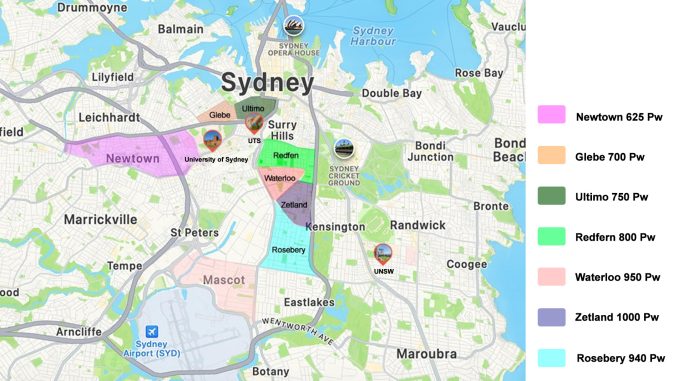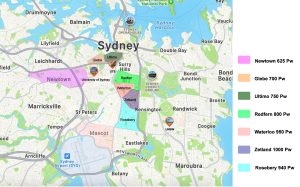
“Two weeks before the start of the semester, I was still browsing rental apps and sent dozens of applications, but all of them were rejected. In the end, I had to share a house with three strangers and live in the living room.” – Laney Liu, an international student from China at the University of Sydney.
On the bustling streets of Sydney, a group of people are quietly experiencing a kind of “double drift”: they come from the other side of the earth and travel across the ocean to study but can hardly find a place to stay on this land.
As the new semester approaches, the pressure of renting a house once again looms over tens of thousands of international students. High rents, tight housing supply, information asymmetry, and institutional shortcomings have made “difficulty in renting a house for international students” an invisible crisis.
The dream of studying “squeezed” by rent
In 2024, rents in major Australian cities reached a record high in the past decade. According to the Australian Rental Report (Q1 2025), the median rent of independent houses in Sydney has exceeded A$690 per week, and apartment-type residences are also close to A$650 per week. For international students with limited income, this means that “renting a room with a door” has become a luxury.
Laney Liu told the author: “I wanted to find a single room near the school at first, with a budget of less than 500 Australian dollars. Ultimately, I couldn’t find a suitable one at all. Either the location was too far, or the conditions were too poor.” In the end, she shared a two-bedroom apartment with three classmates she met on Xiaohongshu. She lived in the living room with another classmate, and the three of them had to share a bathroom.
Many international students like Laney Liu live in “informal” spaces. On social platforms such as RedNote, you can see a large number of posts about “sleeping in the living room” and “being cheated in renting a house.”
High-risk rental under the information gap
Compared with local students, international students face not only economic pressure but also cultural and institutional barriers. Due to a lack of rental experience and local common sense, many international students fall into scams or illegal intermediary traps. Alina, a real estate agent at Harmony Realty Group, pointed out: “We have received many international student clients and found that they generally do not know much about the rental process and laws and tend to ignore the details of the contract when signing. Some people did not even confirm whether the landlord has the legal right to rent.” The author’s investigation revealed that some agents would even refuse to handle repair requests from international students or add unreasonable terms to the contracts.
The gap between policy and reality
The Australian government has emphasized in many official documents that international education is a “key export industry.” In 2023, international students are expected to contribute more than A$40 billion to the Australian economy. But in terms of housing support, reality lags far behind policy commitments.
At present, the number of student dormitories provided by Australian universities is limited and expensive. According to the official website of Sydney University accommodation, the price of a basic single room is between A$450 and A$ 659 per week, which is much higher than the normal market price. For international students with limited financial conditions, this is not a viable option.
Housing shortages also expose the mismatch between local governments and universities in planning. Some universities continue to expand the number of international students but fail to provide corresponding accommodation resources or urban infrastructure at the same time.
The ignored “international student crisis”
In government and university data reports, international students are often defined as “education investors” and “cultural exchange messengers,” but few people listen to their voices as “tenants” and “residents.”
A latest study published by Australian researchers in the international authoritative journal “Higher Education” in the field of education points out,the housing needs and housing difficulties of international students have long been marginalized in policy discussions. They are “dehumanized” by economic data and are often regarded as “scapegoats” for driving up rents rather than a group that should be included in the housing security system.
This structural neglect has given rise to collective responses among students. On social platforms, many international students have spontaneously organized “housing mutual aid groups” and “landlord blocklist sharing tables.” Even some students marched outside the school to protest against the high rent. Shame and anger are spreading in the community, and this is not just a response to housing pressure but also a protest against the loss of identity and belonging.
Visualizing the pain point: inequality in data and maps

Through bar charts and maps, readers can view the visualization results of rent levels and the distribution of colleges and universities in each district, and intuitively feel the asymmetry between rent peaks and educational resources.
Appeal and hope
Housing problems should not be an obstacle on the road to study. International students not only need a visa and an acceptance letter, but also an affordable, legal and safe “home”.
Our report calls for:
- Colleges and universities should increase the supply of affordable student dormitories, especially for freshmen and economically disadvantaged groups;
- Local governments should cooperate with schools to jointly supervise the rental market and prevent rental fraud;
- The media and the public need to pay more attention to the real difficulties of international students in housing, medical care, mental health, etc., and regard them not only as “economic resources” but also as “members of society.”
“We just want to find a place to sleep peacefully.” Laney Liu said softly.
We want to hear your voice
🌍 Want to know your rental rights? Check out our guide to NSW rental laws.
🔬 International student stories: Do you have a bad rental experience or tips? Share your stories in the comments!





Be the first to comment